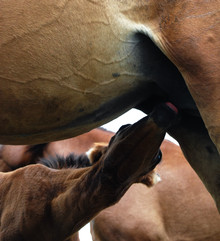It is widely believed that being born is about the most stressful thing that can happen to anybody. But being weaned cannot be too far behind it in the list of traumatic experiences. How weaning takes place can have a dramatic effect on the length of time required to overcome the shock. That this is so, at least for horses, comes from the latest work of researchers in Austria.

A nursing foal
All foals lost weight after being separated from their mothers and the levels of stress hormones in their saliva were similar to those found when horses are transported, which is known to be associated with a high degree of stress.
In the wild, horses are usually weaned for about a year, typically until their mothers are next about to give birth. Weaning takes place gradually -- the mothers discourage their young from suckling and do not produce as much milk -- and so the foals gradually come to rely on other sources of food.
Contrast this idyllic picture with the situation of domestic animals, which are generally removed from their mothers abruptly and at a much earlier age. The young animal is suddenly deprived of its main source of nourishment as well as of the emotional security that the mothers provide. And the mothers no longer have young to care for, which as any human mother will confirm represents a significant change in lifestyle.
With increasing attention being paid to animal welfare, new and more "humane" weaning methods are being gradually introduced. Nevertheless, there have to date been relatively few investigations of whether the new methods actually improve the situation.
Christine Aurich and colleagues at the University of Veterinary Medicine, Vienna (Vetmeduni Vienna) have filled this gap in our knowledge by comparing the levels of stress suffered by foals when weaned by different methods.
In collaboration with Sandra Rose-Meierhöfer of the Leibniz Institute for Agricultural Engineering, Potsdam-Bornim and with other scientists at Vetmeduni Vienna, Regina Erber in Aurich's group elected to examine three ways in which female foals can be separated from their mothers.
One group of foals (A) was subjected to the "short, sharp shock" method: the mothers were all removed from the foals' stable at once.
Another group (B) was treated in the same manner but two other mares, not related to any of the foals, were present from the foals' birth until the end of the experiment.
The final six foals (group C) were subjected to sequential removal of the six mothers, with two mothers taken away each day for three days. The animals' behaviour was closely monitored to see how they adapted to independent life, levels of stress hormones in the foals' saliva were measured and their heart rates were followed (changes in heart beat are associated with stress).
The results were dramatic. The most obvious conclusion was that weaning under any circumstances is extremely stressful. All foals lost weight after being separated from their mothers and the levels of stress hormones in their saliva were similar to those found when horses are transported, which is known to be associated with a high degree of stress.
The hormone level immediately after weaning was not found to depend on the method of weaning, so it seems that irrespective of the weaning procedure the animals are discomfited. But there were nevertheless significant differences in how long it took the foals to come to terms with life without mum.
The researchers found that foals in groups A and C needed much longer to gain weight after weaning than foals in group B and showed many other classical signs of stress, e.g. they whinnied more often and spent more time walking around, presumably searching for their mothers.
It is clear, then, that weaning foals in the presence of other mares helps reduce the length of time they suffer. Aurich interprets the results in relation to the situation in wild horses. "We know that horses in the wild usually live in family groups, with one mature stallion and several mares with their offspring.
Having other mares present when foals are weaned is thus closer to the natural situation and seems to help compensate for the removal of the foals' mothers."
The presence of a "support group" seems to help foals accept the loss of their mothers but the researchers have not yet considered how the mothers may be helped to come to terms with no longer having their foals around them. Can it be assumed that they are happy to be free again?
Story Source:
The above post is reprinted from materials provided by Veterinärmedizinische Universität Wien.
